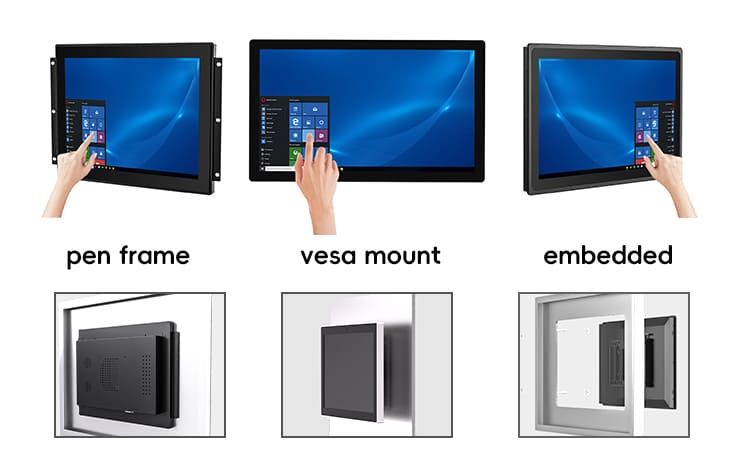Panel PC: An In-Depth Overview
Panel PC, also known as panel computer, is an all-in-one device that integrates a display screen and a computer system. The following is a detailed introduction to Panel PC:
Definition and Applications
Panel PC refers to a type of all-in-one device that integrates a display screen and a computer system. Typically equipped with touchscreen functionality, it is designed for installation in various industrial and commercial settings to monitor and control various processes.
It is widely used in industrial automation sectors such as manufacturing plants, oil and gas industries, automotive manufacturing, food and beverage industries, and water and wastewater treatment, running HMI/SCADA software to enable operators to oversee and manage production processes.
Features
Integrated Design: Combines the display screen and computer system into a single panel, reducing external connections and devices, saving space, and enhancing system reliability and ease of use.
Diverse Installation Options: Offers flexible installation methods such as panel mounting, VESA mounting (flat-panel display mount interface), desktop placement, embedded installation, rack mounting, or DIN rail mounting, facilitating installation in different environments and equipment.
Ruggedness: More robust than standard office computers, Panel PCs are designed to withstand harsh industrial conditions including dust, humidity, temperature fluctuations, and vibrations. They often have IP protection ratings to effectively prevent the ingress of dust, water, and liquids.
Touchscreen Technology: Most Panel PCs come with touchscreens supporting various technologies like capacitive touchscreens (PCAP) and resistive touchscreens. PCAP touchscreens offer higher visibility, brightness, and reliability, while resistive touchscreens are more practical in environments where operators need to wear gloves.
Fanless Cooling Technology: To adapt to the dust and vibrations in industrial settings, Panel PCs commonly employ fanless cooling technology, relying on heat sinks for passive cooling, reducing internal moving parts, and enhancing system stability and reliability.
Performance and Functionality
Processors and Storage: Equipped with processors of varying performance levels, ranging from low-power ARM processors to high-performance Intel Core i7 processors, to meet the demands of different applications. Adequate memory and storage space are also provided to support complex industrial applications.
Connectivity: Features a rich array of connection options, including Ethernet, USB, serial ports, CAN bus, RS232, RS485, GPIO, POE, aerospace connector, Phoenix terminal etc., enabling connections with various industrial devices and sensors. Many modern Panel PCs also support Wi-Fi and Industrial Internet of Things (IIoT) functionalities for convenient data transfer and remote monitoring.
Expandability: Some Panel PCs offer expansion slots or interfaces, allowing users to add additional hardware modules such as extra storage devices or communication modules as needed to meet specific application requirements.

Advantages
Enhanced Operational Efficiency: Touchscreen operation simplifies the user interface, reducing reliance on traditional keyboards and mice, enabling operators to perform tasks more quickly and intuitively, thereby increasing work efficiency.
Reduced Maintenance Costs: The integrated design and fanless cooling technology reduce the number of internal components and potential failure points, lowering maintenance costs and system downtime.
Flexibility and Adaptability: With diverse installation methods and connection options, Panel PCs can be easily integrated into different industrial systems, adapting to a variety of complex application scenarios.
Renowned Brands and Products
Siemens AG
SIMATIC Panel PC 477B Embedded: Known for its robust design and high-performance processor, it is capable of operating reliably in harsh industrial environments.
Simatic IPC Series: Boasts high-quality displays and consistent, reliable performance, integrating breakthrough touchscreen technology with a rugged design, making it an ideal choice for the most challenging industrial settings.
Advantech Co., Ltd.
PPC Series: Offers a comprehensive range of products with both fanless and fan-equipped designs, available in sizes from 6.5″ to 23.8″, supporting expansion, TSN (Time-Sensitive Networking), and a rich array of I/O interfaces, meeting the needs of most industry applications.
MIC-770-20A1 IPC: Compact and fanless, designed for industrial environments, equipped with the 10th generation Intel Core CPU and H480W chipset, with recommended CPU models being i5-10500E or better.
Beckhoff Automation
CP Series: Provides multi-touch functionality, scalable performance, and a rugged design suitable for various industrial applications, making it a versatile product in the field of industrial automation.
Panel PC 2200 Multi-touch: Based on the Apollo Lake architecture, its dual-core and quad-core processor technology sets a milestone for embedded systems, offering the best cost-performance ratio and high flexibility, allowing all second-generation Automation Panels to be transformed into complete PC systems with Panel PC 2100.
B&R Industrial Automation
Panel PC 2100 Series: Recognized for its unparalleled computing power and compact design, its innovative design and outstanding performance make it stand out in the field of industrial automation.
Panel PCs, with their robust construction, integrated design, and extensive functionality, have become an ideal choice for industrial automation and control applications. They offer enhanced operational efficiency, reduced maintenance costs, and the flexibility to adapt to a wide range of complex scenarios. Moreover, the availability of CUSTOMEND Panel PCs allows users to tailor the devices to their specific needs, further enhancing their utility in modern industrial environments. Whether for standard applications or highly specialized tasks, Customend Panel PCs provide a reliable and efficient solution, making them an indispensable tool in today’s industrial landscape.
